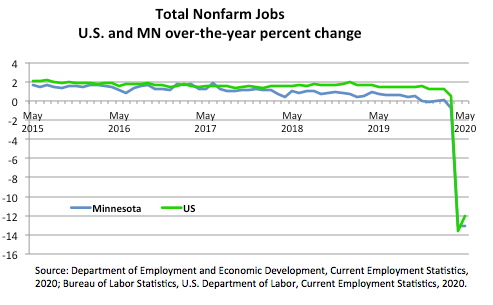by Nick Dobbins
July 2020
Monthly analysis is based on unadjusted employment data.
The Minneapolis-St. Paul-Bloomington MSA added 80,204 jobs (4.5 percent) in June, as the easing of some COVID-19-related restrictions on businesses helped buoy employment numbers across the state. All but one supersector added jobs on the month, with growth led by Leisure and Hospitality, which was up 34,715 jobs (34.7 percent). Other Services, which was helped by the easing of restrictions on personal care service businesses such as barber shops and hair salons, added 9,045 jobs (14.3 percent), the second largest proportional monthly growth. The second largest real employment growth came in Trade, Transportation, and Utilities, which was up by 12,914 jobs (4 percent), with most of that driven by the addition of 12,737 jobs in Retail Trade (up 7.4 percent). Over the year the metro area lost 189,212 jobs (9.2 percent). It was the only MSA with worse over-the-year job growth than the state as a whole, which was off by 9.1 percent. While the losses were nearly unprecedented, it was still a notable improvement from May’s 12.5 percent decline. The largest declines were once again in Leisure and Hospitality, which was down 65,788 jobs (32.9 percent) on the year. Every supersector in the area had negative annual job growth. The smallest decline came in Financial Activities, which was off by 3.6 percent or 5,785 jobs.
The Duluth-Superior MSA added 6,893 jobs (5.7 percent) over the month of June, outpacing the state’s 4.7 percent growth over the same period. Leisure and Hospitality employment was up by 5,487 or 67.2 percent. Trade, Transportation, and Utilities added 747 (3.3 percent). All but three supersectors in the area added jobs, with Government losing 191 (0.8 percent), the largest real and proportional decline. Over the year the area lost 11,362 jobs (8.2 percent). Unlike other areas of the state, the largest losses came in Mining, Logging, and Construction (down 1,985 jobs or 19.1 percent) and Information (down 265, 20.4 percent). However, Leisure and Hospitality and Other Services also had substantial over-the-year declines, off by 2,149 jobs (13.6 percent) and 1,022 jobs (15.9 percent), respectively. Government employers lost 2,103 jobs (8.1 percent) with most of those losses coming at the Local Government level. No supersector in the area added jobs on the year.
The Rochester MSA added 4,974 jobs (4.4 percent) in June. Leisure and Hospitality led in both real and proportional growth, adding 1,900 jobs or 26.3 percent. Trade, Transportation, and Utilities was up 835 jobs (5 percent) with most of that growth coming in Retail Trade (up 803 or 7.2 percent). Educational and Health Services added 1,002 jobs (2.1 percent), and Other Services was up 7.9 percent (252 jobs), the second largest proportional growth. Only two supersectors, Information and Financial Activities, lost jobs on the month, and both of those declines were less than 0.5 percent. Over the year the Rochester area lost 8,352 jobs (6.7 percent), well below the state’s 9.1 percent decline. Leisure and Hospitality had the largest proportional decline (down 24.2 percent or 2,920 jobs) and Educational and Health Services had the largest actual decline, losing 3,746 jobs or 7.3 percent. Three supersectors in the area added jobs on the year, with significant increases in Mining, Logging, and Construction up 2.6 percent (143 jobs) and Manufacturing up 149 jobs (1.3 percent).
The St. Cloud MSA added 5,556 jobs (5.5 percent) in June. While Leisure and Hospitality was the big mover at the state level, Manufacturing led the growth in St. Cloud in both real and proportional terms, adding 3,134 jobs or 27.3 percent. Leisure and Hospitality had the second-largest proportional growth, although it was a more modest 8.4 percent (266 jobs). Trade, Transportation, and Utilities added 1,107 jobs (4.9 percent), with most of that growth coming in Retail Trade (up 1,012 or 7.4 percent). The only supersector to lose jobs on the month was Government, down 820 or 5.5 percent. Over the year the St. Cloud MSA lost 4,643 jobs (4.2 percent). It was the best over-the-year performance of any MSA in the state, including the two areas shared with North Dakota, which generally show smaller over-the-year losses than Minnesota. Three supersectors had positive job growth on the year (Mining, Logging, and Construction; Trade, Transportation and Utilities; and Educational and Health Services). Leisure and Hospitality had the largest real and proportional job losses, off by 2,886 jobs or 34.5 percent.
The Mankato-North Mankato MSA added 3,406 jobs (6.6 percent) in June. It was the highest proportional over-the-month job growth of any MSA in the state. Most of the growth came from the private sector, which added 3,322 jobs (7.8 percent), while public sector employers added 84 jobs (0.9 percent). Service providers added 3,059 jobs (7.4 percent), and goods producers added 347 (3.3 percent). Over the year the Mankato-North Mankato area lost 2,952 jobs (5.1 percent), outperforming the state’s 9.1 percent over-the-year loss. Service providers lost 2,675 jobs (5.7 percent), and goods producers lost 277 jobs (2.5 percent).
The Fargo-Moorhead area added 2,537 jobs (1.9 percent). It was the lowest over-the-month job growth of any MSA in the state, possibly because of its proximity to areas primarily in North Dakota not experiencing as sharp a decline in the early stages of the COVID-19 response. Over the year the area lost 7,074 jobs (4.9 percent), which was the best over-the-year performance of any MSA in the state. Leisure and Hospitality lost 4,114 jobs (28.2 percent), while Professional and Business Services added 1,089 jobs (7.6 percent), the largest real and proportional growth of any supersector.
The Grand Forks-East Grand Forks MSA added 1,435 jobs (2.9 percent) in June. Leisure and Hospitality led the growth, adding 1,043 jobs or 28.3 percent. Over the year the MSA lost 4,078 jobs (7.4 percent). The largest proportional decline came in Leisure and Hospitality (down 18.8 percent or 1,097 jobs), while the largest real decline came in Government employment (down 1,534 jobs or 11.5 percent).
